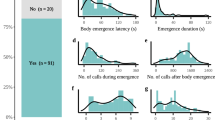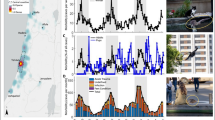Abstract
I have read with much interest the communication by W. A. King-Webster and J. S. Kenny1 in which it is suggested that roosting bats can play a considerable part in cave excavation where the rock is soft. In particular, reference is made to the existence, in the roof of a limestone cave in Mt. Tamana (Trinidad), of bell-shaped cavities ranging in depth from 3 ft. to 6 ft., and in diameter at the mouth from 1½ ft. to 2½ ft., and which are used by sleeping bats. The suggestion is made that the habit of the bats of alighting at the lower edge of the bell and then jostling upwards into a central position, by continuation over innumerable years, has led to the excavation of these cavities, with maximum removal of rock at the mouth of the bell.
This is a preview of subscription content, access via your institution
Access options
Subscribe to this journal
Receive 51 print issues and online access
$199.00 per year
only $3.90 per issue
Buy this article
- Purchase on SpringerLink
- Instant access to full article PDF
Prices may be subject to local taxes which are calculated during checkout
Similar content being viewed by others
References
King-Webster, W. A., and Kenny, J. S., Nature, 181, 1813 (1958).
Bretz, J. Harlen, J. Geol., 50, 675 (1942).
Davis, W. M., Bull. Geol. Soc. Amer., 41, 475 (1930).
Hooper, J. H. D., and Hooper, W. M., Proc. Zool. Soc., Lond., 127, 1 (1956).
Author information
Authors and Affiliations
Rights and permissions
About this article
Cite this article
HOOPER, J. Bat Erosion as a Factor in Cave Formation. Nature 182, 1464 (1958). https://doi.org/10.1038/1821464a0
Issue date:
DOI: https://doi.org/10.1038/1821464a0



